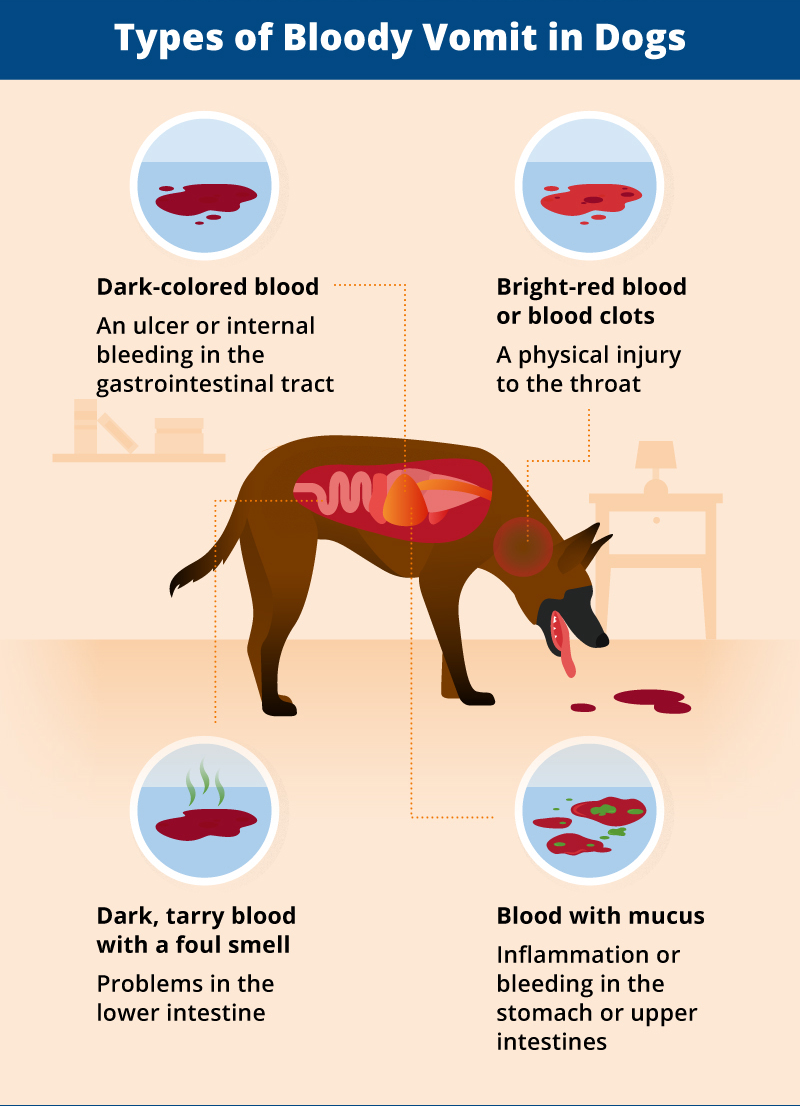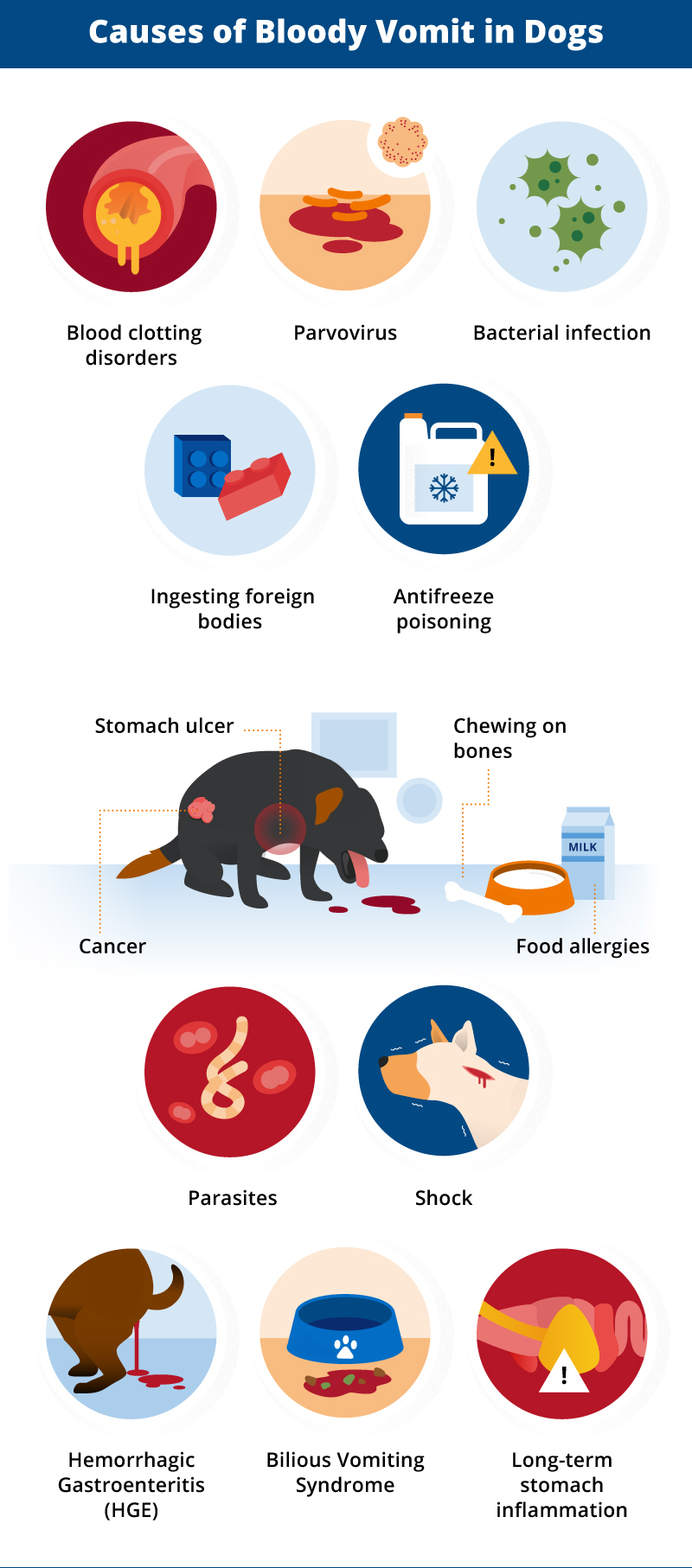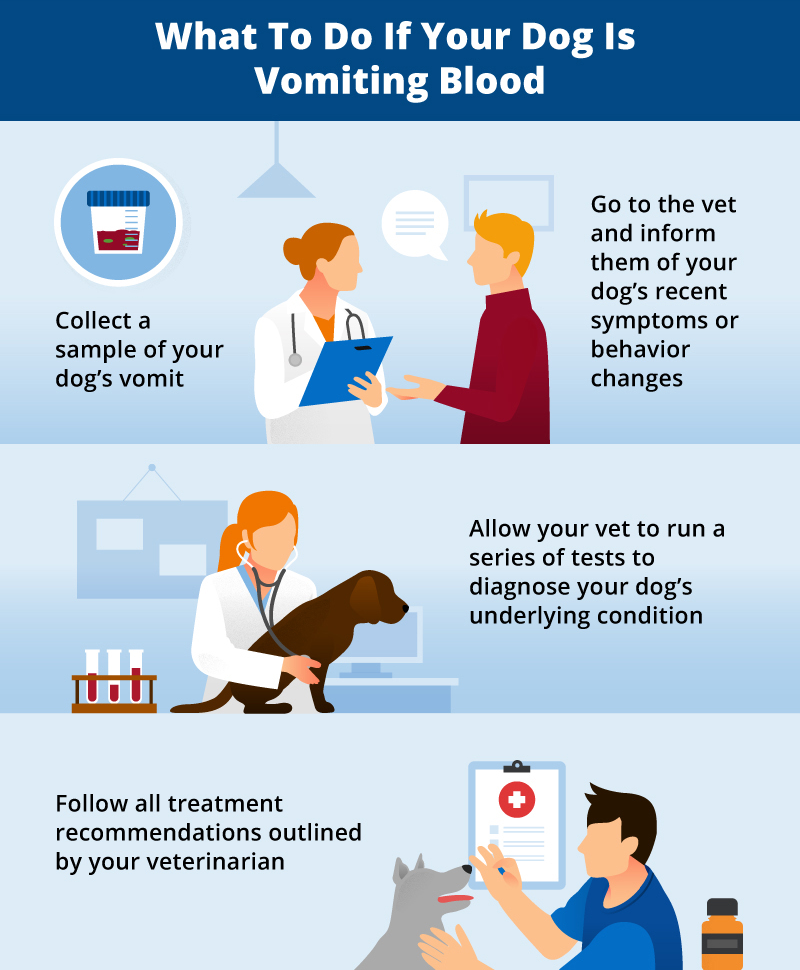Needless to say, it is scary to see your dog throwing up blood. If the blood isn’t coming from a minor cut in the dog’s mouth, the first thing you should do is visit a veterinarian. Internal bleeding from the stomach or intestines can be deadly, but it depends on what is causing the problem.
The severity of the situation also depends on how much your dog is bleeding. Small amounts of bright-red blood or blood clots in vomit are usually caused by a physical injury to the throat. Blood that is dark-colored or looks like coffee grounds is more likely to be due to an ulcer or internal bleeding located deeper in the gastrointestinal tract.
Whatever the diagnosis, it is not normal for a dog to throw up blood, and you should bring a sample of bloody vomit to your veterinarian for laboratory analysis. This will help you get a faster diagnosis – especially if your dog is vomiting blood because he has a rare illness.
What It Means If Your Dog Is Vomiting Blood
If your dog is vomiting up blood, it likely means he is bleeding internally. The most harmless explanation is that your dog cut his mouth while chewing on something or playing with another dog. There are also far more serious explanations – like canine cancer or parvovirus infections that are often deadly. This is why it is essential to see a vet.

Vomit that is high in mucous and blood usually means that the dog’s stomach or upper intestines are inflamed, ulcerated, or bleeding. Bile is often present as well when the source of the irritation is in the upper intestine (duodenum). When there are problems in the lower intestine, the blood is usually digested, dark red or tarry, and smells unpleasant. Unless the source of the bleeding is obvious, your dog will need tests to find out where the blood is coming from.
Before you go to the vet, it is a good idea to make a list of all the things your dog may have eaten. This might help you avoid a few medical tests, but in most cases, veterinarians will order a slew of tests to find out why your dog is vomiting blood. It can be a very expensive and stressful ordeal.
Causes of Bloody Vomit in Dogs
Vomiting up blood is a medical condition called hematemesis. The first clue to finding out what is causing hematemesis is how the vomit looks. If the blood is fresh, it may look like bright-red specks, streaks or clots. If the blood is older or partially digested in the stomach before it was thrown up, the vomit might look like black coffee grounds.
The color depends on how long the dog has been bleeding internally and what part of the dog’s digestive tract is bleeding. In general, bright red blood means the bleeding is in the mouth, throat, stomach, or upper intestines. Vomiting blood that is black or dark red in color means the blood has been in the body for a longer period. Vomiting darker-colored blood could also mean the dog has a stomach ulcer or he is bleeding deep in the intestines.
Ingesting Foreign Bodies
Lots of things can cause bloody vomit in dogs, but the most common cause of bloody vomit is when a dog ate something he shouldn’t have. This is mostly a problem for puppies who get into the trash when unsupervised – especially if they are going after an old chicken carcass or bones – but some dogs will eat tennis balls, Christmas ornaments, socks, coins, fishing lures, rocks, jewelry and more.
Another possibility is that your dog ate something toxic or poisonous. For example, garlic is poisonous to dogs because it damages their red blood cells, and dogs with severe garlic poisoning may vomit blood after ingesting it.
Chewing on Bones
Dogs have been chewing on bones for thousands of years, but it can be dangerous if the bones shatter into sharp pieces in your dog’s jaws. Most of these sharp fragments will dissolve rapidly in the dog’s stomach acid without needing surgery, but they can potentially puncture the stomach or intestines and cause peritonitis – a life-threatening situation in which bacteria escape the intestine.
If your dog is vomiting blood after eating a bone, it is usually because he is bleeding from minor cuts in his mouth. It is far more serious if bones get stuck in the dog’s throat, stomach or intestines. Emergency surgery is needed if a large bone gets stuck or blocks the intestines.

Antifreeze Poisoning
Antifreeze is a sweet-smelling chemical that keeps your car windshield ice-free, but less than 3-ounces of the substance is enough to poison a medium-sized dog. Vomiting is an early symptom of antifreeze poisoning.
Over 72 hours after ingesting antifreeze, a dog will start bleeding internally and vomiting blood. Antifreeze poisoning is often deadly, even with immediate treatment. So, if you believe your dog has swallowed antifreeze, take him to an emergency vet immediately.
Bacterial Infection
Like humans, dogs may vomit blood if they get food poisoning or develop a bacterial infection with salmonella, E. coli, clostridia, campylobacter and more. These infections are also known as “hemorrhagic gastroenteritis.” They are most common in younger dogs in kennels or dogs with vulnerable immune systems. Infections may also cause bloody diarrhea, appetite loss, pain, fatigue, or fever in dogs.
Stomach Ulcers
Dog vomit that looks like coffee grounds is likely to be caused by an ulcer or bleeding in the stomach. Stomach ulcers are painful sores on the inner lining of the stomach that do not heal very well because they are constantly being re-injured by acid and food that is being digested. This leads to chronic inflammation and bleeding. Ulcers can also be caused by medications like NSAID painkillers, steroids, and aspirin.
Parvovirus
Veterinarians dread dealing with a dog who is vomiting blood because it might be due to parvovirus, one of the deadliest diseases in dogs and puppies. If a dog gets parvo, he will become desperately ill very quickly – and most likely will not survive.
There is no cure for parvo – antibiotics do not work. With early and aggressive emergency treatment, many dogs survive parvo. It is critical to go to the vet right away because the chances of survival decrease when the vomiting becomes bloody.
Food Allergies
Vomiting is a normal response if your dog has a food allergy. This symptom may appear shortly after switching to a new food. If the dog has a severe allergy, you may notice blood in his vomit and stools. The most common allergies in dogs include food additives (flavorings, sweeteners, preservatives, etc.), dairy, wheat, corn, eggs and fish.
A dog may also gradually become allergic to food he has eaten for years. Moving to a new neighborhood or other stressful changes in the dog’s environment can sometimes trigger these hypersensitivity reactions.
Blood-Clotting Disorders
Vomiting blood is caused by internal bleeding, and internal bleeding is sometimes caused by blood-clotting disorders. If the body is unable to make blood clots, it may be a sign of a genetic disorder like hemophilia. It may also be a sign of low blood platelet count due to an underlying illness like thrombocytopenia, liver failure, or cancer in dogs.
Exposure to certain toxins and pesticides can also cause problems with blood coagulation. For example, rat poison contains an anti-coagulant medication called warfarin that doctors often prescribe to humans who are at risk of blood clots. Dogs who catch a rat or get into a rat trap may be exposed to this blood-thinning pesticide and suffer internal bleeding. The first sign of this may be vomiting blood. Other signs include bleeding under the skin and easy bruising.
Parasites
Vomiting blood might mean your dog has hookworms – a common parasite that chews holes in the intestines and feed on blood. Hookworms attach themselves to the intestinal lining and inject a blood-thinning toxin to keep the blood flowing.
Hookworms occasionally detach and find another spot in the intestines, leaving a still-bleeding site behind. If there are a high number of hookworms in a dog’s intestines, the dog may start vomiting blood – and will likely have bloody diarrhea as well.
Cancer
A diagnosis of cancer is rare, but it is far more likely in older dogs. Vomiting blood may be the first symptom. There are many types of cancer in dogs that can cause bloody vomit, but stomach cancer is the most likely culprit. Tumors of the esophagus or stomach can also potentially cause a dog to vomit blood.
The less-common types of cancer that cause bloody vomit include leiomyoma, carcinoma, and gastrinoma. These tumors can be large fleshy masses, or subtle infiltrations in the stomach and intestines.
Bilious Vomiting Syndrome
If your dog is vomiting a lot because he has a normal flu or virus, you might eventually start to notice specks of blood. Over time, persistent or severe vomiting will break blood vessels in the stomach and cause minor bleeding. This will cause streaks or spots of bright red blood to appear in the vomit.
This type of persistent vomiting is called “bilious vomiting syndrome” and it is more common in dogs with giardiasis or inflammatory bowel disease. The vomiting usually happens on an empty stomach, late at night or early morning.
Long-Term Stomach Inflammation
Long-term stomach inflammation in dogs, also known as “chronic gastroenteritis,” is a medical term for intermittent vomiting for a few weeks that is caused by inflammation of the lining of the stomach. The stomach lining can be irritated by hyper-acidic syndromes, auto-immune diseases, metabolic or endocrine diseases, and more.
Older dogs and small-breed dogs like Lhasa Apsos, Maltese, Shih-tzus and Miniature Poodles are more susceptible to long-term gastritis. It can also be a problem in some larger-breed dogs, like the Basenji and Drentse Patrijshond. The frequency of vomiting and the bloodiness of the vomit may increase as the stomach inflammation progresses.
Hemorrhagic Gastroenteritis (HGE)
Hemorrhagic gastroenteritis (HGE) is a disease in dogs that causes sudden diarrhea and vomiting. It usually occurs in otherwise healthy dogs. This condition is characterized by vomiting mucous that is streaked with blood, as well as diarrhea. The vomiting usually begins with mucous and bile and then becomes bloody over time.
HGE is most dangerous for small dog breeds because it can rapidly lead to dehydration and kidney failure from loss of fluids. The exact cause of HGE remains unknown, but it may be related to dietary changes, allergic reactions or eating non-food items. Hyperactivity, stress, and anxiety in dogs may also contribute to HGE.
Other Health Problems
In some other diseases of the kidney, spleen, liver, or pancreas, blood can get into the intestinal tract and mix in the stomach, resulting in a dog vomiting blood when he starts feeling sick. These diseases are usually accompanied by other worrying symptoms like diarrhea, loss of appetite, weight-loss, weakness, excessive thirst or abdominal pain.
Shock
The most serious problem associated with dogs vomiting blood is hypovolemic shock, which is a life-threatening condition in which there is not enough blood-flow to the body due to excessive bleeding. Unless the bleeding is stopped, the dog may suffer organ failure or death.
Bloody vomit may also be a sign of septic shock. This type of shock is usually related to bacteria in the bloodstream (also called “septicemia”) or toxicity from eating a poisonous substance.
Diagnosing Bloody Vomit in Dogs
A veterinarian is your best bet for finding out why your dog is vomiting up blood – and the diagnosis may not be easy. If it is an emergency like an intestinal obstruction or major bleeding, your veterinarian must find the obstruction or the source of the bleeding before performing surgery.
If the dog is not in an immediately life-threatening situation, a veterinarian may do a blood count, organ screening, blood-clotting profile, X-rays, fecal analysis, and other tests. The veterinarian may also need to find out how much blood has been lost and if the dog has a blood-clotting disorder that is preventing the clots that stop bleeding. If your dog is vomiting blood, the best and safest option is to have him examined immediately by a vet.

Sources:
- “Vomiting of Blood in Dogs.” PetMD, Accessed 8 Sep. 2017. www.petmd.com/dog/conditions/digestive/c_multi_hematemesis.
- Brown, Jackie. “Is Your Dog Vomiting Blood? What to Do Next.” Dogster, 24 Aug. 2018, Accessed 8 Sep. 2017. www.dogster.com/dog-health-care/dog-vomiting-blood-what-to-do.
- Allen, Meredith. “Is Your Dog Throwing Up Blood? Here’s What To Do.” PetCareRx, 12 June, Accessed 8 Sep. 2017. www.petcarerx.com/article/is-your-dog-throwing-up-blood-heres-what-to-do/1325.
- “Vomiting Blood in Dogs – Definition, Cause, Solution, Prevention, Cost.” WagWalking, 23 May 2017, Accessed 8 Sep. 2017. www.wagwalking.com/symptom/why-is-my-dog-vomiting-blood.
- “My Dog Is Vomiting Blood:10 Possible Causes.” VetInfo, Accessed 8 Sep. 2017. www.vetinfo.com/dog-vomiting-blood.html.




